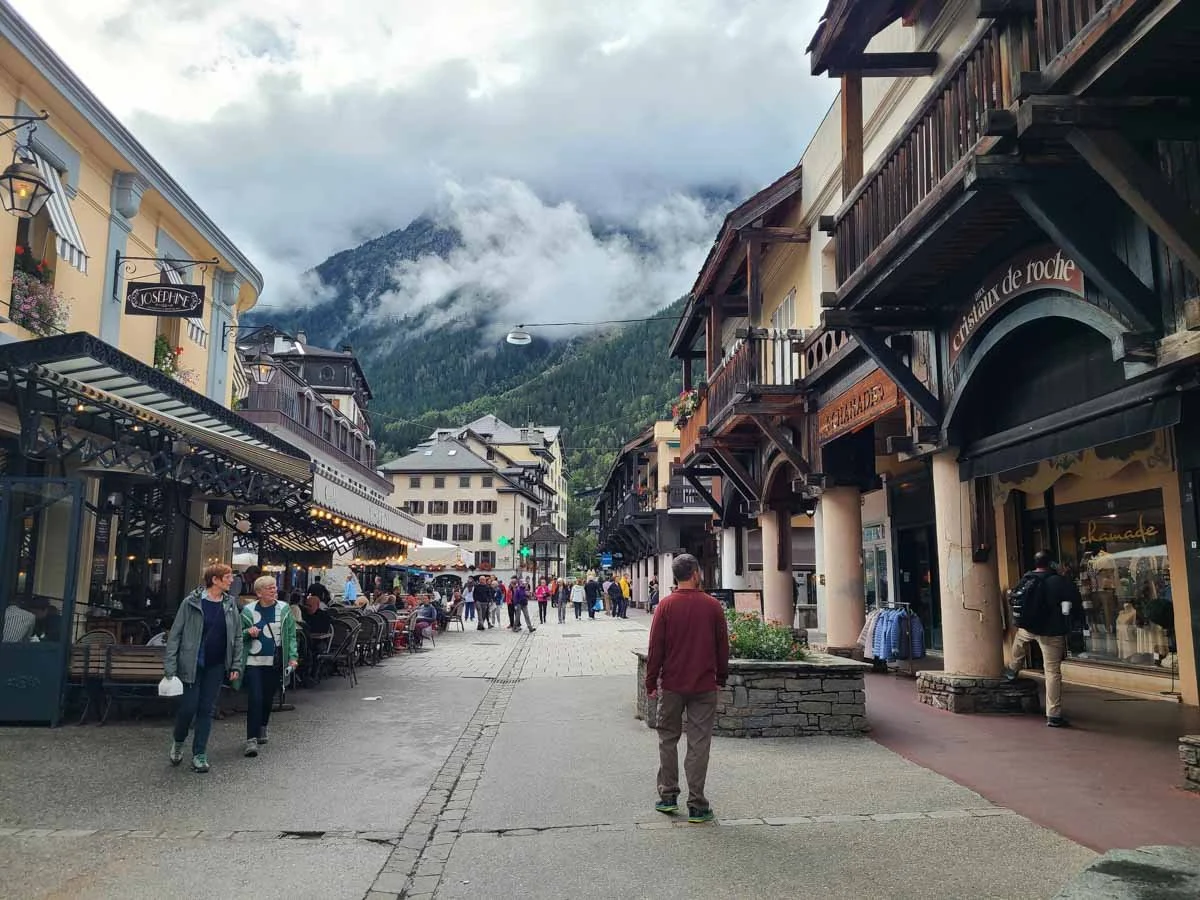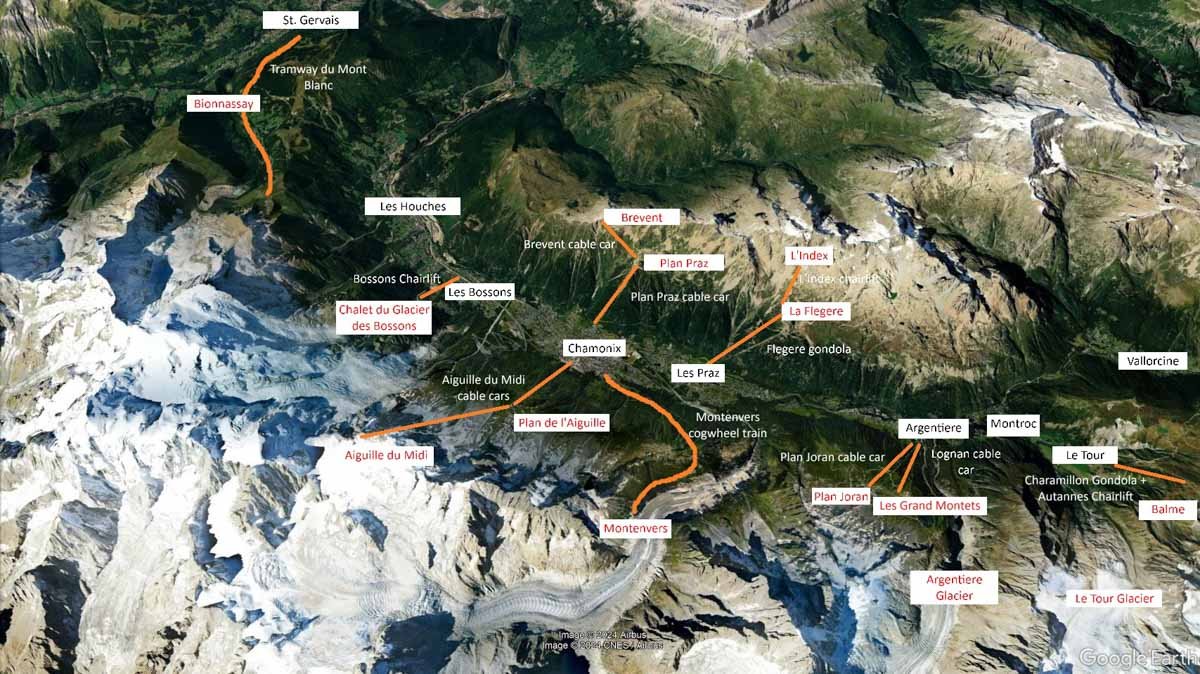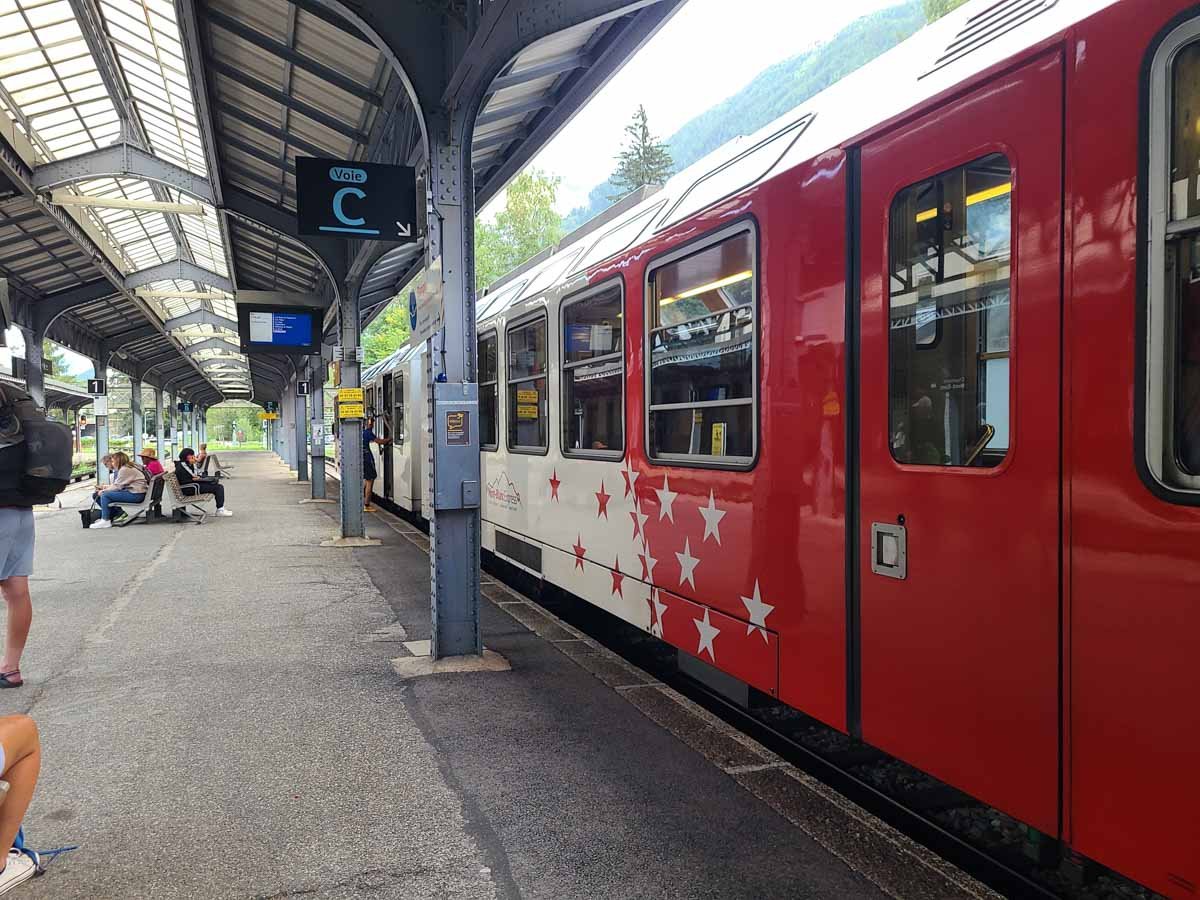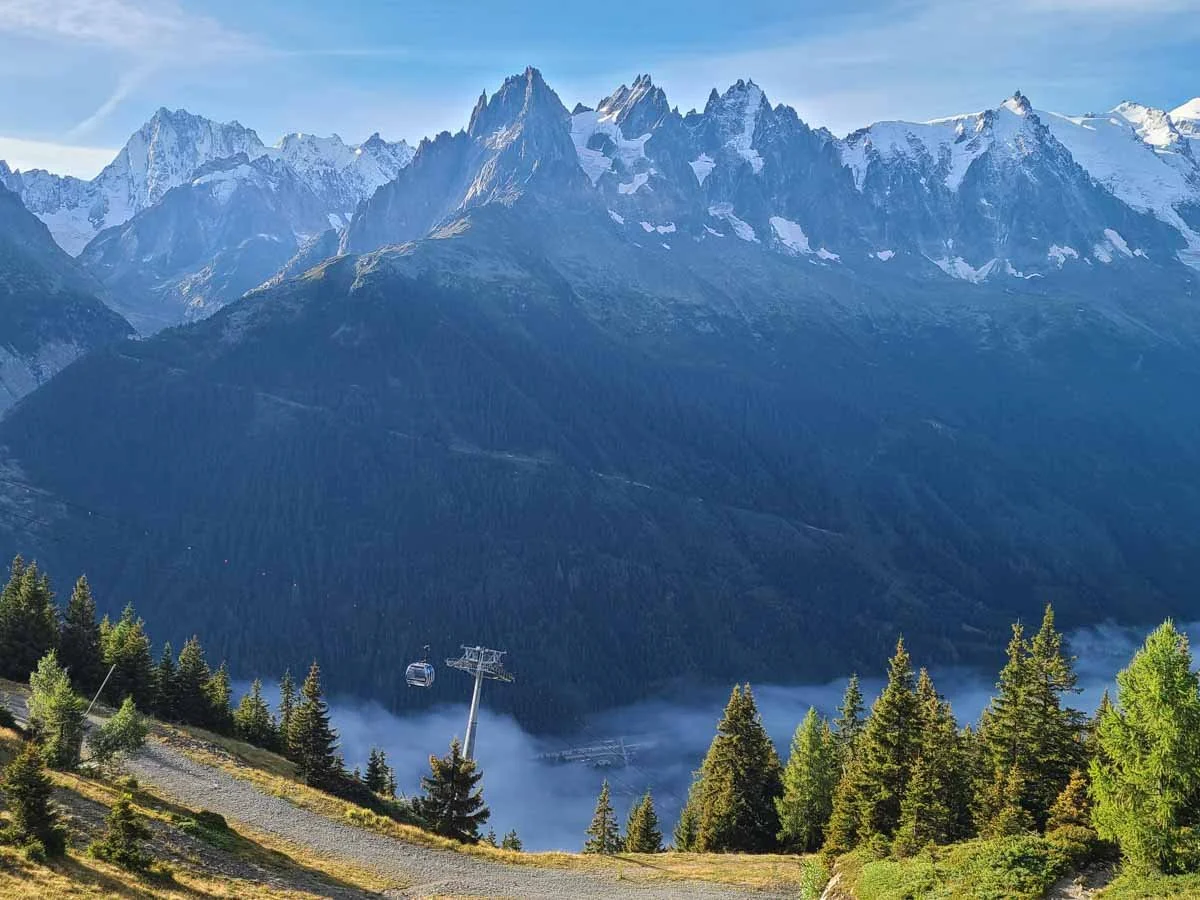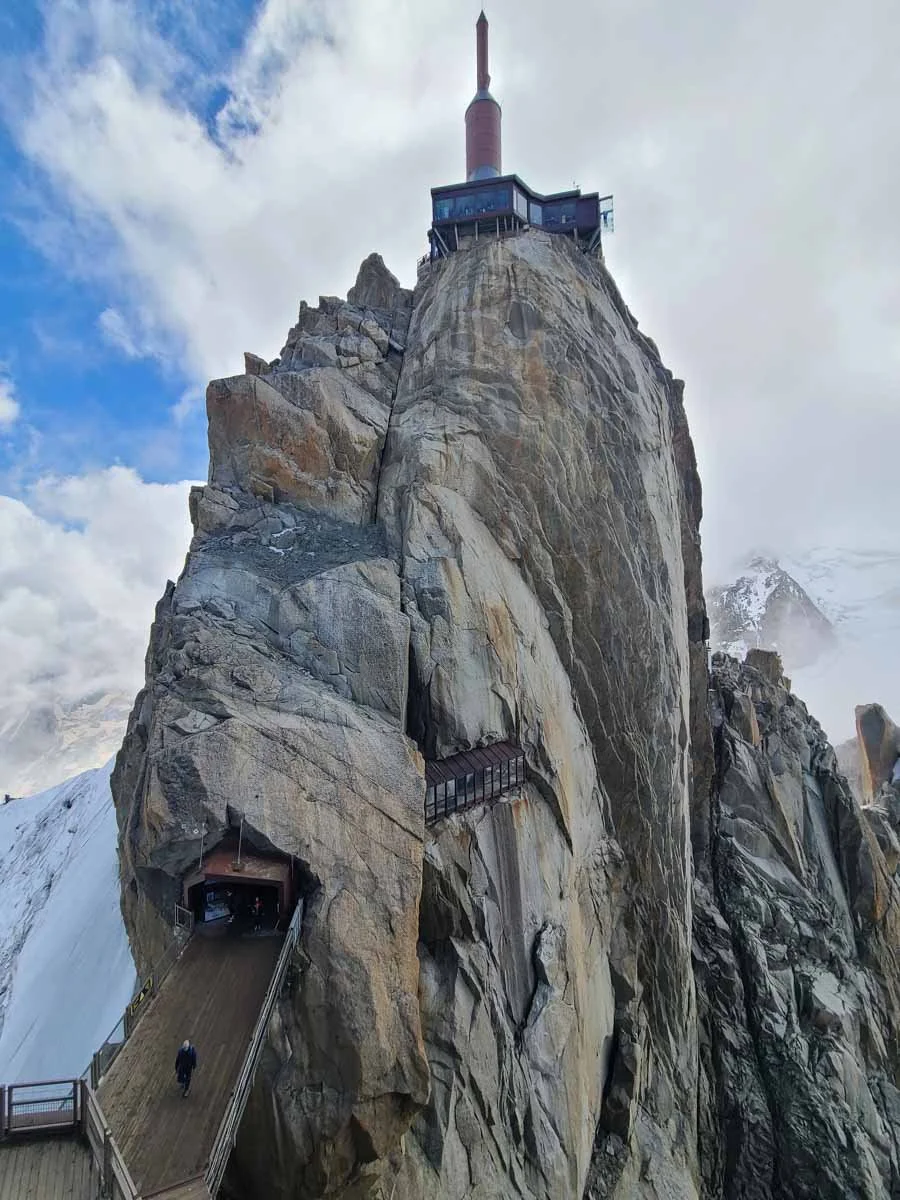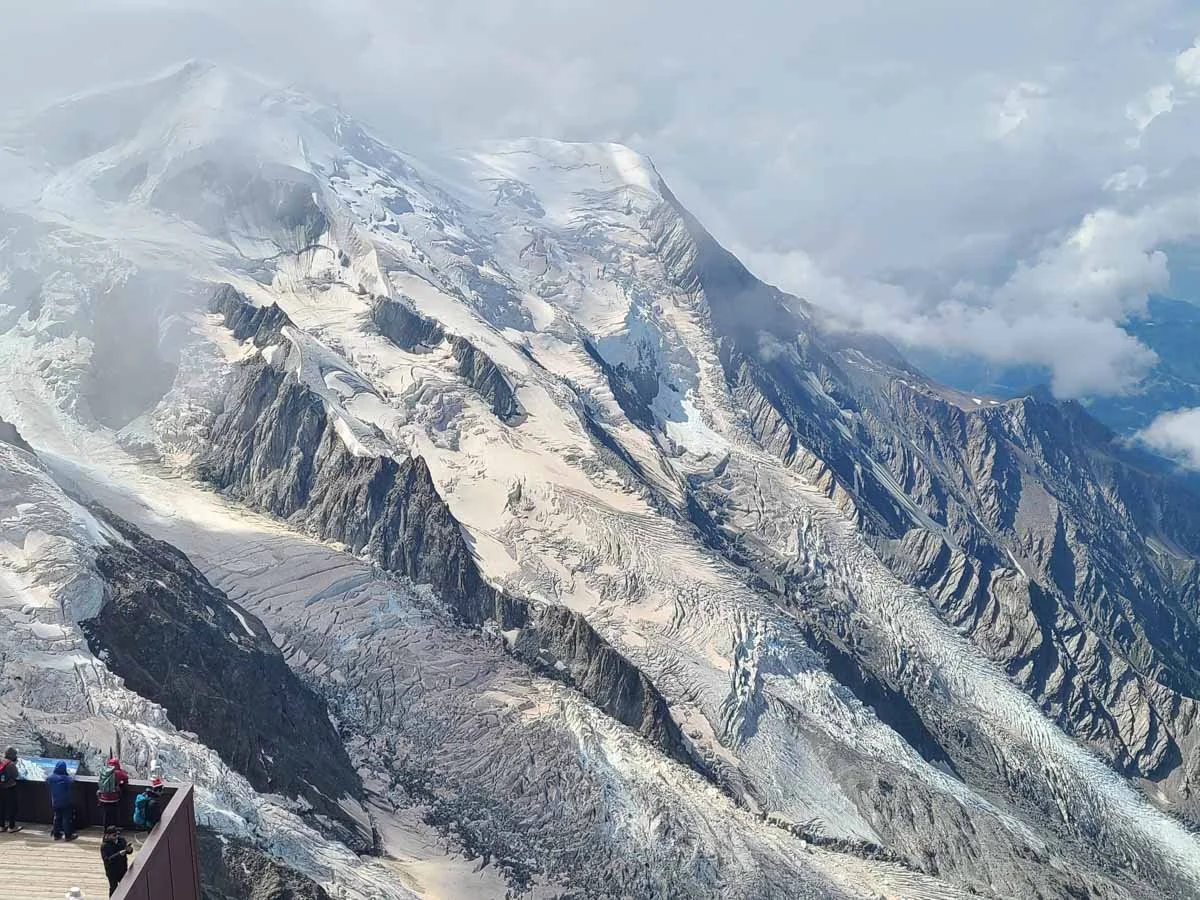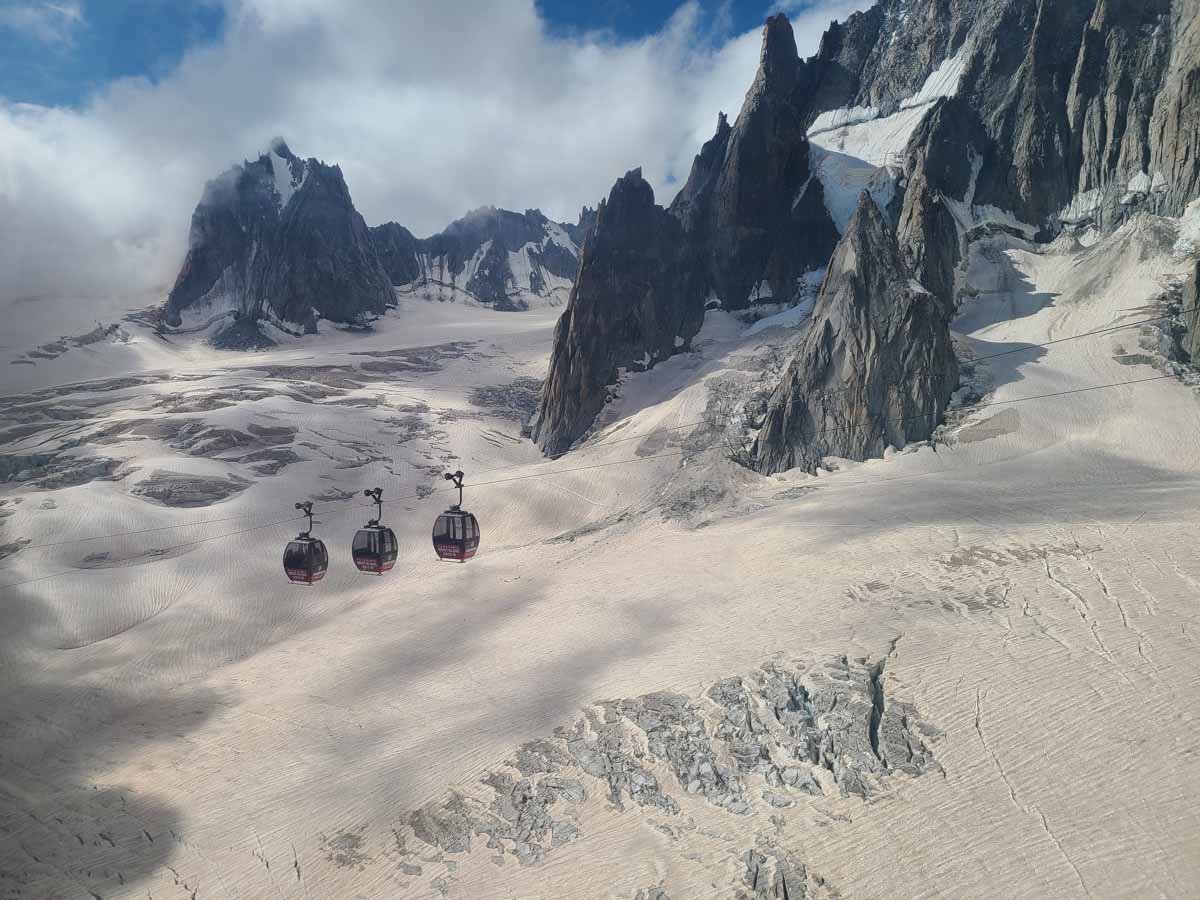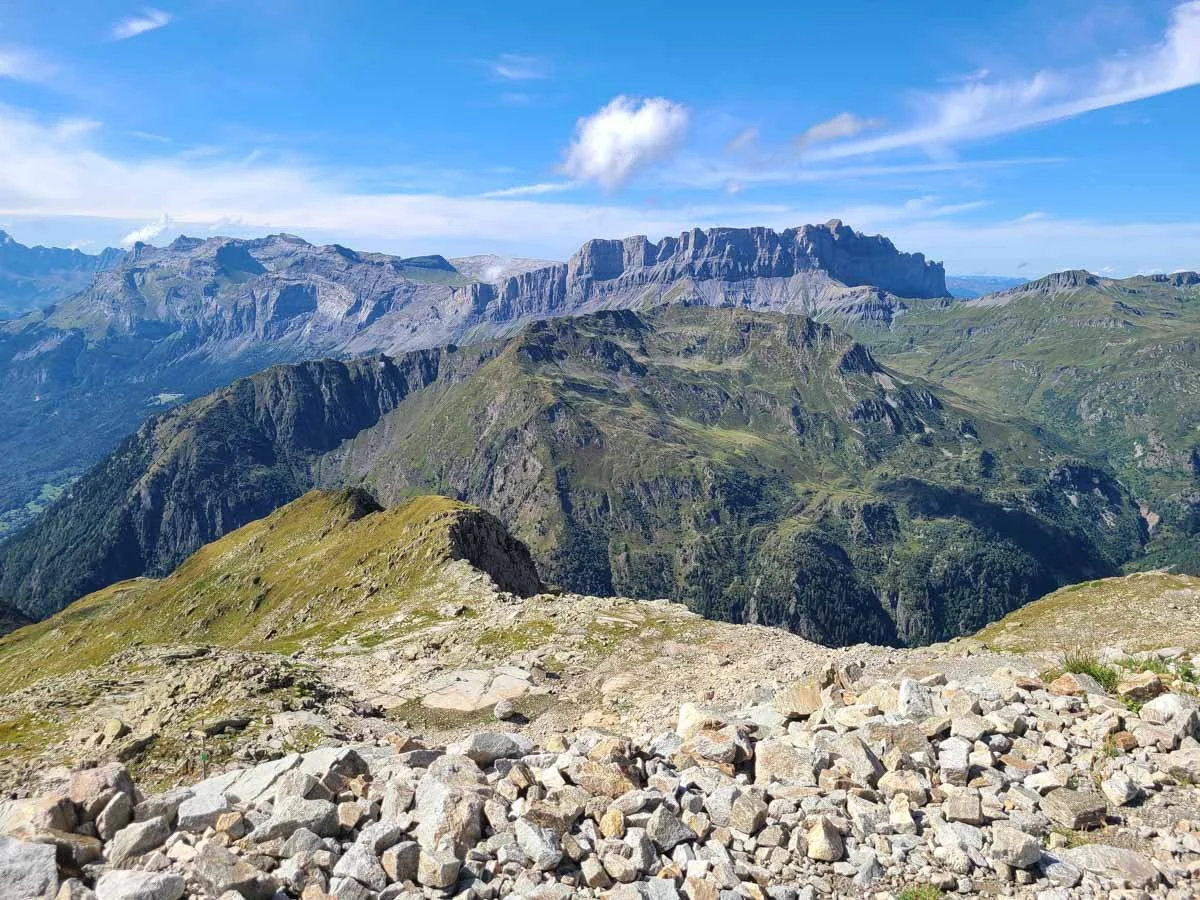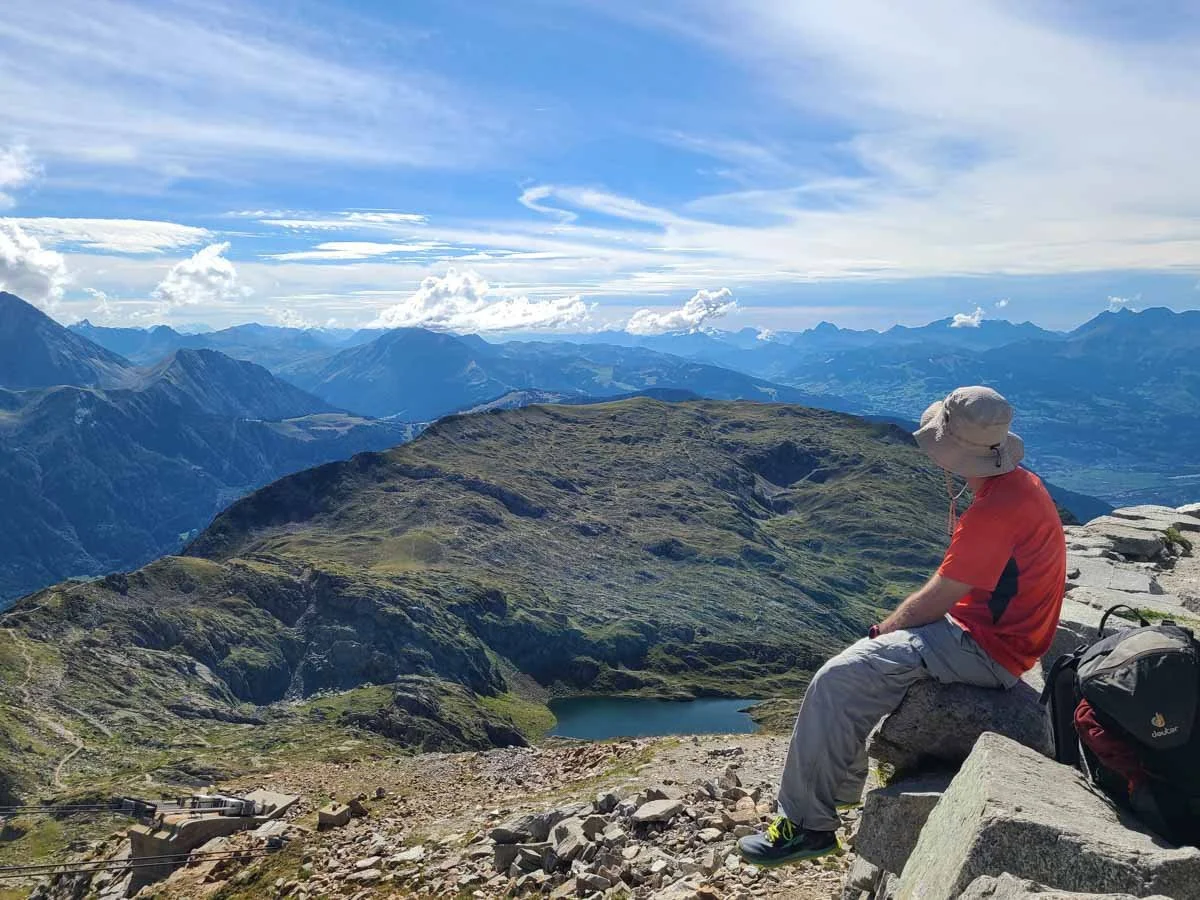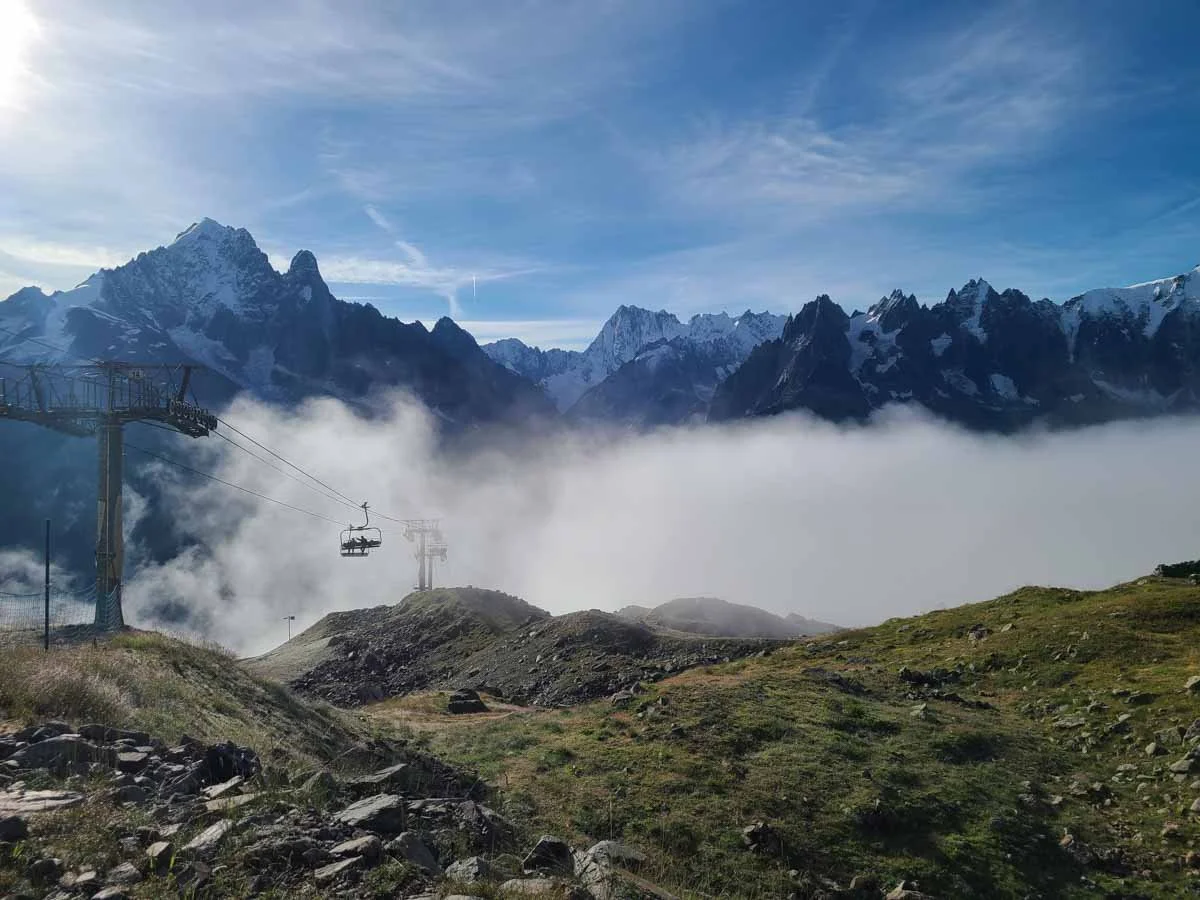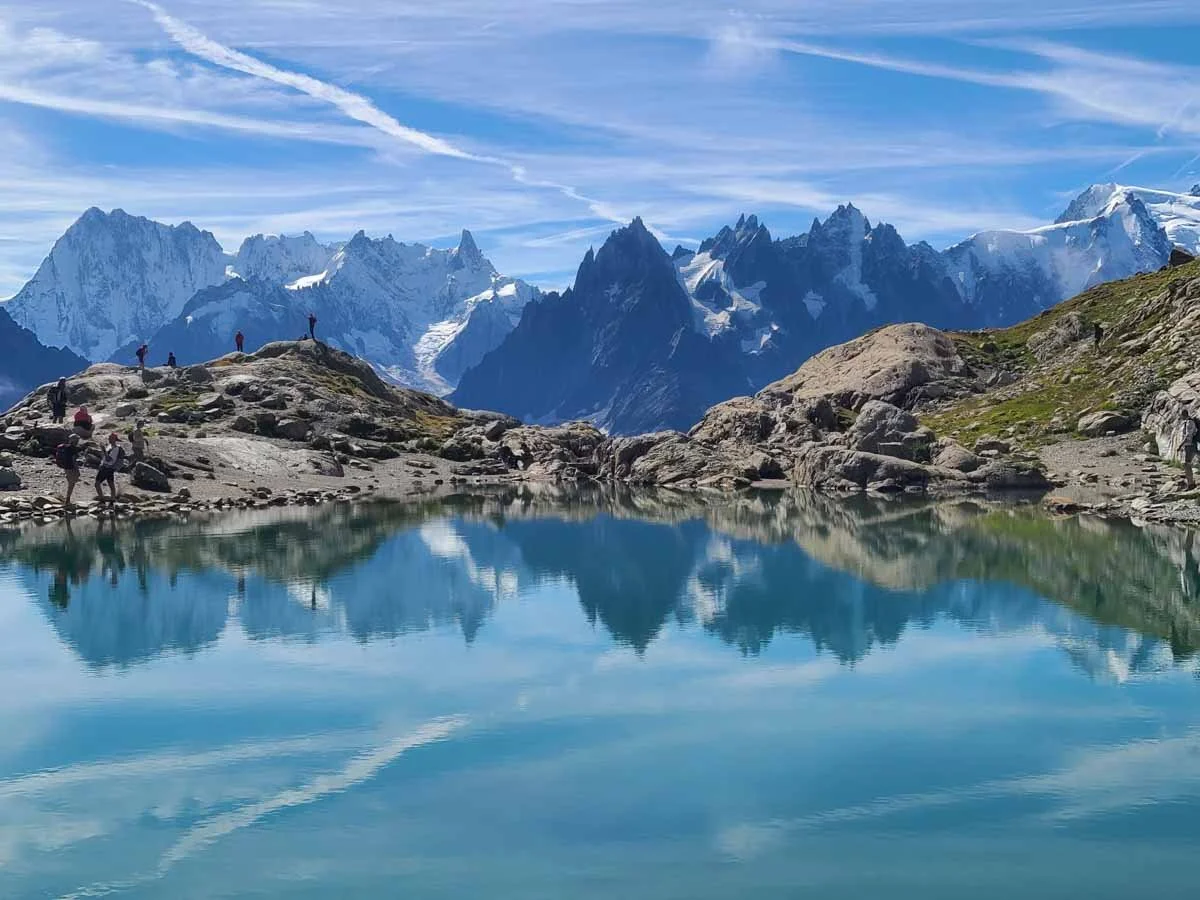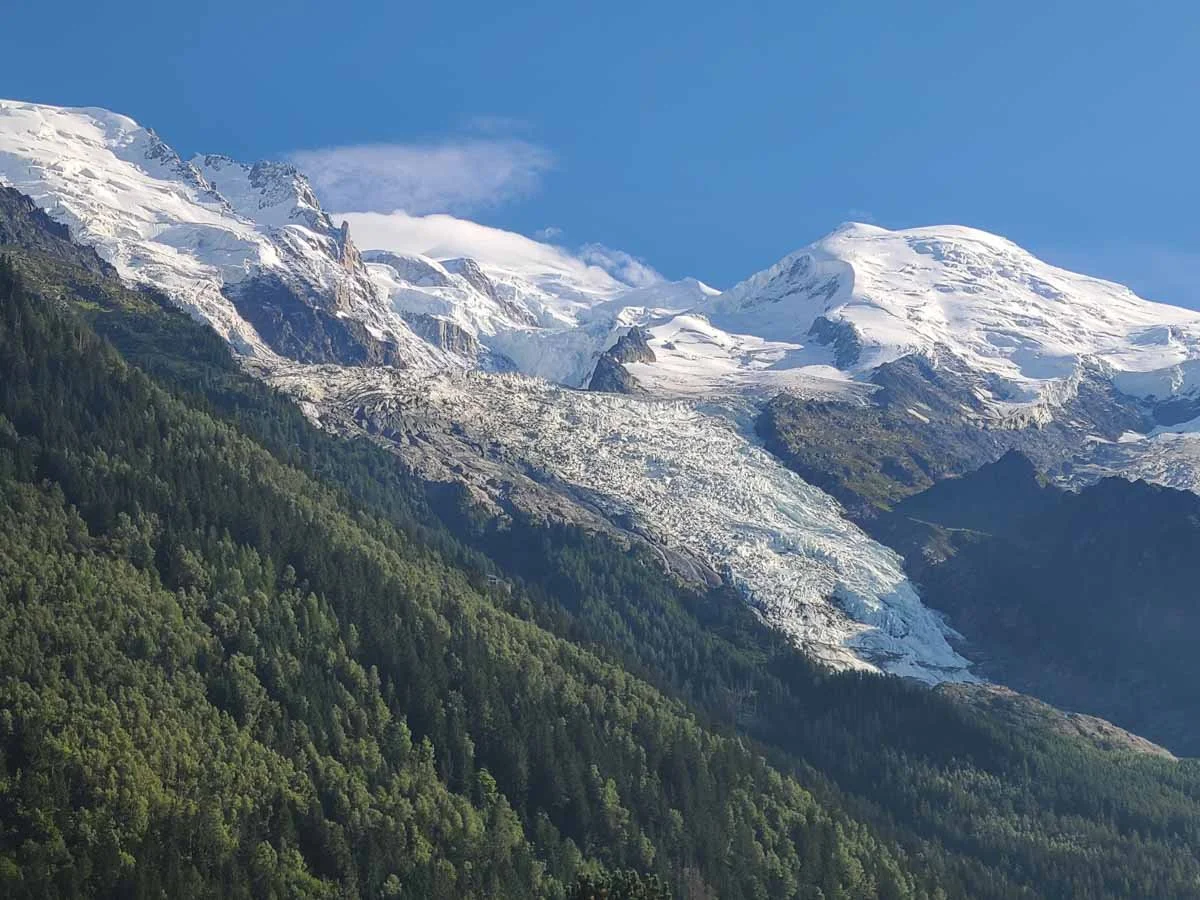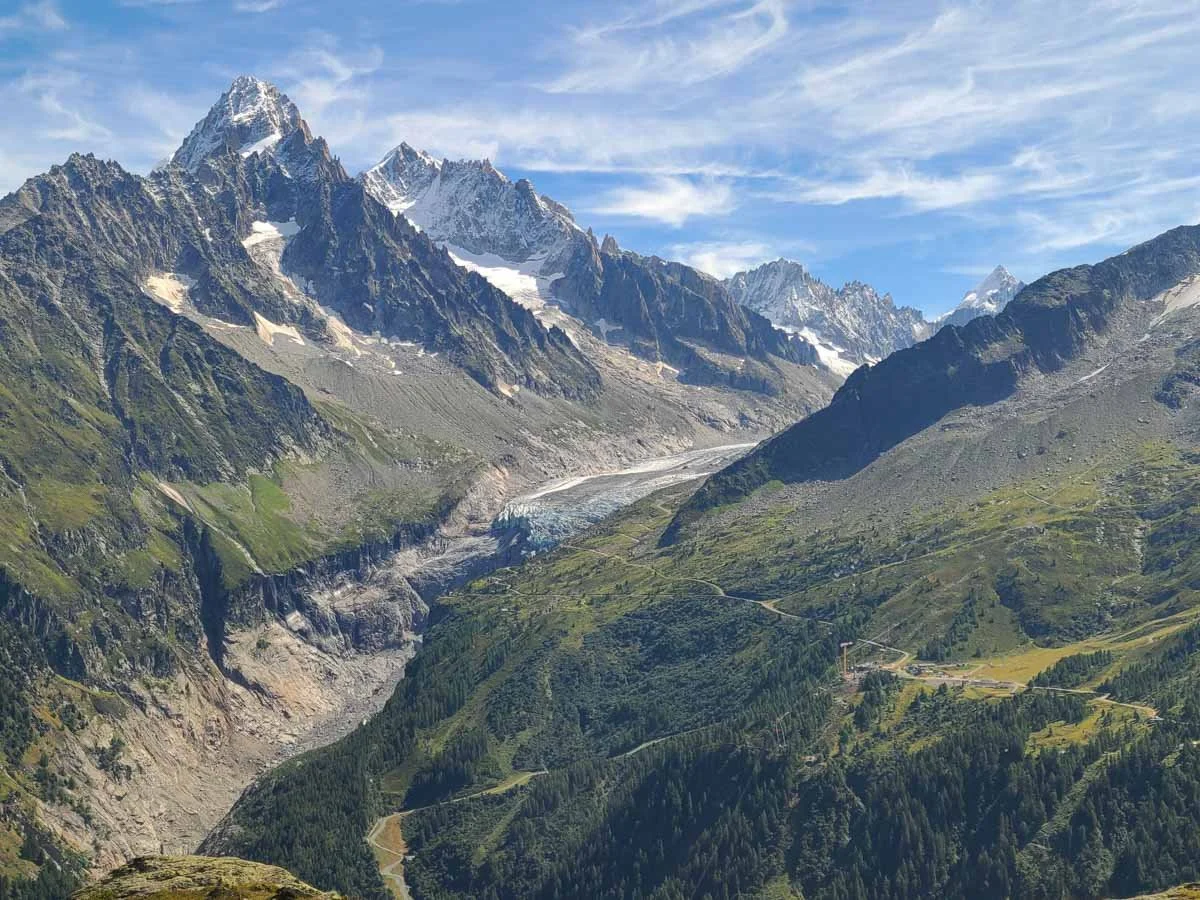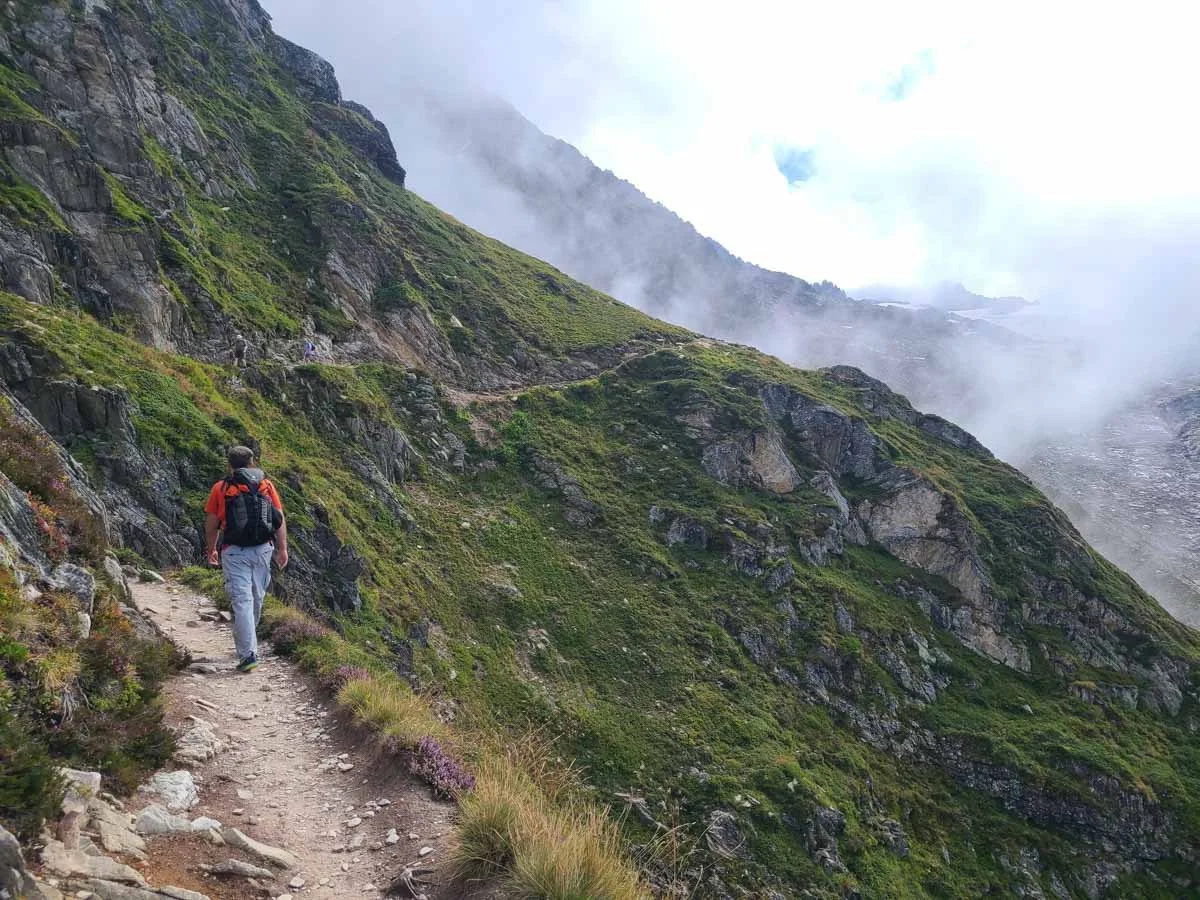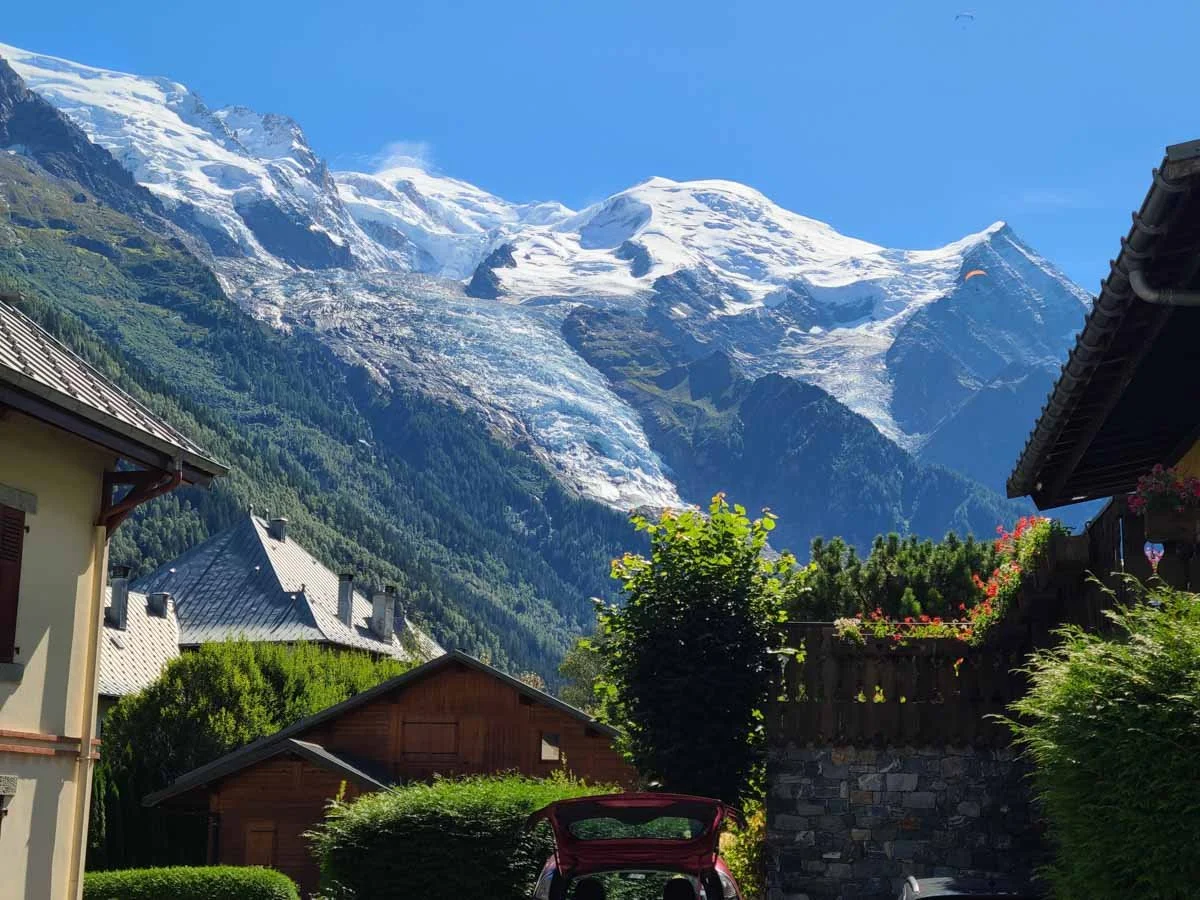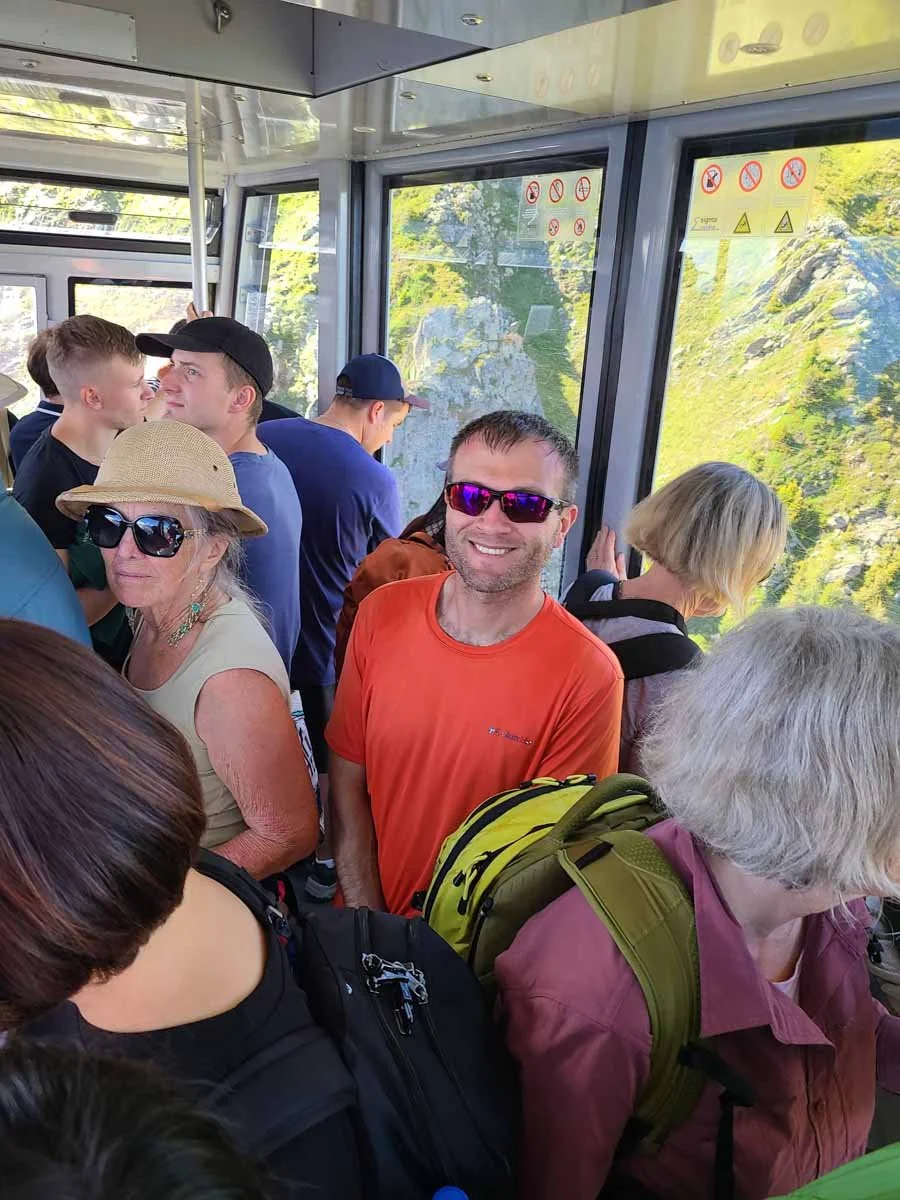Best Things to Do in Chamonix (+ Complete Chamonix Summer Travel Guide!)
Planning a summer trip to Chamonix and wondering what there is to do? Between epic hiking trails, scenic lifts that bring you up to amazing mountain views, and picturesque mountain towns to explore, there are plenty of things to do in Chamonix in the summer. In this guide, we’ll share all our favorite things to do in Chamonix, plus give you all our top tips for visiting, including how to get around, when to go, what to bring, costs, and more!
The small mountain town of Chamonix, nestled on the eastern border of France, is one of our favorite destinations in the European Alps! Sitting at the foot of the picturesque Mont Blanc, the highest mountain in Western Europe, the Chamonix Valley is surrounded on each side by jagged mountains and beautiful subalpine meadows, and with a combination of scenic gondolas, chairlifts, and cogwheel trains that whisk you up into the mountains, it’s easy to get to incredible viewpoints and the start of epic hiking trails. Down below, you can walk the quaint streets of Chamonix while gazing up at the massive Mont Blanc and its cascading glaciers.
Chamonix is probably best known as a world class ski resort, and this small mountain town is bustling in the winter. But once the snow clears, a whole new opportunity for sightseeing and hiking opens up, and there are tons of amazing things to do in Chamonix in the summer! If you’re an avid hiker or trail runner, or someone who just loves being in the mountains and soaking in the alpine views, then we definitely recommend putting Chamonix on your bucketlist.
Though Chamonix Valley is a relatively small area, it might seem a bit overwhelming to figure out at first. Stretched throughout the valley are a series of small towns, each with their own set of gondolas and lifts that go to different viewpoints, attractions, and hiking trails, and it might seem a bit complicated to piece them all together, determine what passes you need for everything, and figure out how to get around.
But we promise, it really isn’t too bad, and we’re here to help make it all a little bit more clear!
In this guide, we share with you all the best things to do in Chamonix in the summer. Plus, we’ll go over everything you need to know to plan your trip, including how to get around Chamonix, the best time to go, what to pack, what to expect in terms of costs, and more of our best Chamonix tips.
So, let’s get to it!
In this Chamonix guide:
Overview of Chamonix Valley
Walking the quaint streets of downtown Chamonix
While many people simply reference the town of Chamonix, there’s actually a whole string of small mountain towns that run through the valley between the mountains of the Mont Blanc massif on the southern edge and the mountains of the Aiguilles Rouges on the northern edge. Chamonix is the most well-known and picturesque of these towns, and centrally located in the valley. However, many of the best things to do in Chamonix are spread out across the entire valley. Luckily, all the towns in Chamonix Valley are well-connected and easy to get to (we’ll go over this soon!).
Map of Chamonix Valley
We’ve created this map of Chamonix Valley to hopefully help orient you to the area before you start planning your trip! We indicate the different towns located throughout the valley, and we’ve also labeled each of the main gondolas, chairlifts, and cogwheel trains in each town. Use this as a reference for when we talk about all the best things to do in Chamonix later!
A map of Chamonix labeling all the major towns and lifts (in orange) of Chamonix Valley
How to Get to Chamonix
Chamonix is tucked away in a small corner of eastern France that is bordered by both Switzerland and Italy, nearly 6 hours away from Paris.
The best way to get to Chamonix is to actually fly into Geneva, which is the closest major airport to Chamonix at just over an hour drive away.
We found that the best way to get to Chamonix from Geneva is by either bus or shared transfer. You could get a train, but we could only find pretty indirect routes that require transfers and could take up to three hours.
There are several bus companies that go from Geneva airport to Chamonix, such as Flixbus and Easybus (this bus seems preferable for being direct and running more frequently throughout the day). This option is certainly the cheapest for getting from Geneva to Chamonix, but you might have to wait at the airport for a bit depending on the bus schedules, the bus might not be direct depending on the company you go with, and the buses typically only go to the central station right in Chamonix center. If you’re staying right in town then this is a great option, but if you’re staying in another town in Chamonix Valley like we did, that means you’ll still have to grab another bus or train to get there. This isn’t hard (we go over how to get around Chamonix Valley below), but after a long travel day, it might be one more step you just don’t want to have to take.
The view of the Mont Blanc massif and its glaciers while traveling through Chamonix Valley
We actually opted for a shared transfer shuttle from Geneva to Chamonix and were really glad we did. After a 24 hour travel day, we wanted something super easy that would take us right to our accommodation. We went with Mountain Dropoffs which we’d highly recommend. They are definitely pricier, but it’s super convenient. You give them your flight number and time of arrival and they’ll be waiting for you at the airport, and they will drop you off anywhere in Chamonix Valley. You can do private or shared transfers- we opted for shared to save money and traveled with 4 others into the valley.
You can also simply rent a car in Geneva and drive to Chamonix, which would certainly be the quickest way to get there, but once you’re in Chamonix, you really don’t need the car, and we found it’s pretty easy and cheap to get around without one. So, let’s get into that now…
How To Get Around Chamonix Valley
Chamonix Valley is a pretty small and concentrated area. It’s really just a single strip of towns tucked in a valley between two mountain ranges, so it’s pretty simple and straightforward to get around- which is a good thing because if you’re looking to do a lot of the best things in Chamonix we mention later, you’ll definitely need to travel a bit through the valley!
You have several options for getting around Chamonix: by car, by bus, and by train. Let’s go over each one now!
Getting around Chamonix by car
Getting around Chamonix by car is pretty straightforward, and probably the quickest way to get anywhere you’d want to go. But renting a car can be expensive, you’ll have to deal with finding and paying for parking for most things, and with the awesome (and cheap!) public transportation throughout Chamonix Valley, we really don’t think a car is necessary.
It’s super easy to get around Chamonix without a car. The only time we’d recommend coming to Chamonix with a car is if it’s just a small part on a longer road trip for which having your own car already makes sense.
Getting around Chamonix by train
The Mont Blanc Express- Chamonix’s train
We loved the train in Chamonix! It was so simple, easy, convenient, and never crowded or full. The Mont Blanc Express is the single railway that runs up and down the valley between St. Gervais/Le Fayet and Vallorcine, with plenty of stops along the way.
Most of the best things to do in Chamonix are never too far from a train stop (no more than a 15 minute walk), and it runs regularly. You can check here for up-to-date schedules, and the schedules are also posted at each station as well. Schedules change depending on the time of year so be sure to look carefully at the right one!
A train station in Chamonix Valley
We used the Chamonix train for everything except for one time where it made more sense to use the bus. We were staying in Les Houches on the western end of the valley and were headed to Les Praz, which means we needed to pass through the central Chamonix station. Often, the train sits at this central station for 15 minutes or more (sometimes up to 40 minutes) before continuing on. At the time we wanted to take the train and get to Les Praz, it would have been sitting at the station for quite a while to get just one stop over, so it made more sense for us to get the bus.
How much does the Chamonix train cost? Most likely, the Chamonix train will be free for you! Most people spending the night in Chamonix will get a free Guest Card (called the Carte d’Hote) on arrival from their hotel or host (as long as the host’s accommodation is properly registered). Just fill it out on the back with the dates you’ll be in Chamonix and carry it with you for free train travel between Servoz and Vallorcine. If for some reason your host does not have one, you can buy one at the Tourist Office in Chamonix for pretty cheap (9 Euro for the week, or less for fewer days).
Free, quick, and convenient…can you see why we loved taking the Chamonix train?
Getting around Chamonix by bus
Another great and convenient way to get around Chamonix is by taking the public buses. There are tons of stops throughout the valley. They generally run every half hour and bring you super close to all the best things to do in Chamonix. Make sure to check the schedules here, or they are also posted at all the bus stops.
There are several bus lines in Chamonix, but three main ones that you’ll probably be using.
Line 1 runs between Les Houches and Les Praz Flegere (so basically covers the western half of Chamonix Valley).
Line 2 runs between Les Bossons and Le Tour (covering some of the western half and most of the eastern half of Chamonix Valley).
The Mulet Shuttle Bus is a small electric bus that makes stops around Chamonix center.
How much do the Chamonix buses cost? You can buy a ticket right on the bus for 2 Euro a ride (cash only!). There are also daily and weekly rates that you can purchase in advance. A guest card (the same one we mentioned above) will get you a discount (1.50 Euro instead of 2 Euro). But, if you have a Mont Blanc Multipass, riding the buses in Chamonix is free! We’ll talk more about the Multipass in a second (and how it’s most likely worth it for you!).
We found the buses to be a bit more crowded compared to the train, particularly in the mornings (with standing room only at times), and they definitely make a lot more stops than the train, so it could take you longer to get to where you want to go depending on where you’re coming from. If you’re crossing from one end of the valley to another (for example, from Les Houches to Le Tour), you’ll also have to transfer buses from Line 1 to Line 2.
When it comes to taking the bus or the train, we definitely preferred the train for the smoother and quicker ride, but sometimes the schedule and timing might be in favor of the bus. For shorter journeys between neighboring towns, it really doesn’t matter which you take. For longer journeys across the valley, we recommend just taking a look at each schedule to see which one will get you to your destination in the shortest time.
Also keep in mind that while traveling around Chamonix is mostly on the honor system, we found our tickets checked about 50% of the time, and even had some random checks on the bus with officers coming on to look at everyone’s ticket. So make sure to always have your ticket or passes!
Getting around Chamonix by gondola, chairlift, and cogwheel train
Taking in the mountain views from a Chamonix cable car!
While getting around Chamonix Valley requires bus, train or car, often getting to all the best Chamonix attractions and trailheads requires further travel up into the mountains. And to do this, you’ll take combinations of scenic lifts and trains up from the valley. These lifts are generally well-connected to the bus and trains down in the valley, so you’ll never have to walk too far to get to a lift station.
Here is a list of all the main lifts, gondolas, and cogwheel trains that will get you to all the best things to do in Chamonix that we mention later. We list these in the order they’re found in Chamonix Valley heading from St. Gervais/Le Fayet to Vallorcine.
We also list the best train and bus stops to get off for each lift!
Tramway du Mont Blanc
On Google Maps: Tramway du Mont Blanc- Gare de Saint Gervais
Town: Le Fayet or St. Gervais
Train stop: St. Gervais-Le Fayet
Why take it: A scenic train ride to views of the Bionnassay Glacier.
Schedule and cost: Check out the Mont Blanc resort site for schedules (which change based on season), costs for one-way and roundtrip rides, weather, and opening dates.
Les Bossons Chairlift
On Google Maps: Telesiege Glacier Des Bossons
Town: Les Bossons
Bus stop: Les Montquarts on Bus Line 1
Train stop: Les Bossons
Why take it: Brings you to a close- up view of the foot of the Bossons glacier. Also the start of the hike to La Jonction (an epic fill-day Chamonix hike!).
Schedule and cost: Check out the Mont Blanc resort site for schedules (which change based on season), costs for one-way and roundtrip rides, weather, and opening dates.
Aiguille du Midi Cable Cars
The Aiguille du Midi cable car in Chamonix
On Google Maps: Teleferique Aiguille du Midi
Town: Chamonix
Bus stop: Chamonix Sud on Bus Lines 1 or 2
Train stop: Aiguille du Midi
Why take it: A ride up the highest cable car in France to amazing views of Mont Blanc and the Alps.
Schedule and cost: Check out the Mont Blanc resort site for schedules (which change based on season), costs for one-way and roundtrip rides, weather, and opening dates.
Montenvers Cogwheel Train
The Montenvers cogwheel train
On Google Maps: Gare Chamonix Train du Montenvers
Town: Chamonix
Bus stop: Chamonix Center on Bus Lines 1 and 2
Train stop: Chamonix-Mont Blanc
Why take it: A scenic train ride to a view of the Mer de Glace (France’s largest glacier), and the opportunity to visit an ice cave.
Schedule and cost: Check out the Mont Blanc resort site for schedules (which change based on season), costs for one-way and roundtrip rides, weather, and opening dates.
Plan Praz and Brevent Cable Cars
The Brevent cable car
On Google Maps: Telepherique du Brevent
Town: Chamonix
Bus stop: Chamonix Center on Bus Line 1 or 2
Train stop: Aiguille du Midi
Why take it: A series of two cable cars up to a stunning viewpoint of Mount Blanc, and the start of several hikes.
Schedule and cost: Check out the Mont Blanc resort site for schedules (which change based on season), costs for one-way and roundtrip rides, weather, and opening dates.
La Flegere Cable Car and L’Index Chairlift
The Flegere Gondola
On Google Maps: Station La Flegere
Town: Les Praz
Bus stop: Les Praz-La Flegere on Bus Line 1 or 2
Train stop: Les Praz
Why take it: A scenic gondola and chairlift that brings you to the start of the famous Lac Blanc hike.
Schedule and cost: Check out the Mont Blanc resort site for schedules (which change based on season), costs for one-way and roundtrip rides, weather, and opening dates.
Les Grands Montets Area
There are two lift options for this area: The Lognan and Grands Montets Cable Cars, and the Plan Joran Cable Car.
On Google Maps: Les Grands Montets and Telecabine de Plan Joran
Town: Argentiere
Bus stop: Mediatheque on Bus Line 2
Train stop: Argentiere
Why take it: Leads to the trailhead of a short hike to the base of the Argentiere Glacier.
Schedule and cost: Check out the Mont Blanc resort site for schedules (which change based on season), costs for one-way and roundtrip rides, weather, and opening dates.
Charamillon Gondola and Autannes Chairlift (Balme area)
The Autannes Chairlift
On Google Maps: Domaine du Tour
Town: Le Tour
Bus stop: Le Tour on Bus Line 2
Train stop: Montroc Le Planet
Why take it: Leads to numerous trailheads in the Vallorcine and Le Tour region, including the Refuge Albert Premier Hut.
Schedule and cost: Check out the Mont Blanc resort site for schedules (which change based on season), costs for one-way and roundtrip rides, weather, and opening dates.
As you can see, there are quite a few lifts, chairlifts, gondolas, and trains in Chamonix, and it might be a bit overwhelming to figure out the logistics of it all. But trust us… it’s pretty easy, especially when you know all the right passes to get. So, let’s get into that now!
What Passes Do I Need in Chamonix?
Here are the essentials passes you need to get for traveling in Chamonix!
Chamonix guest card
As we mentioned above, the Chamonix Guest Card, or the Carte d’Hote, gives you free access to the Mont Blanc Express, so it’s super useful to have! Make sure to get it from your accommodation when you arrive.
Individual lift tickets
Each of the lifts and gondolas we listed above have their own tickets. You can buy one-way or roundtrip tickets in advance online using the links above, or you can buy them in person at the ticket offices right at the lifts. The only two that require advanced reservations for specific timeslots are the Aiguille du Midi and the Tramway du Mont Blanc. All the others were easy to just go to the station, buy a ticket (or scan your pass), and hop on.
At the time of writing, these are the roundtrip prices of some of the Chamonix lifts that you might take just to give you an idea of what costs are, but be sure to head to the Mont Blanc website to get the most up to date prices for one way and return trips, families, and kids.
Roundtrip from Chamonix to Aiguille du Midi: 78 Euro
Roundtrip from Chamonix to Brevent: 39.50 Euro
Roundtrip from Chamonix to Montenvers: 39.50 Euro
Roundtrip from Les Praz to Flegere: 23 Euro
Roundtrip from Les Praz to L’Index: 39.50 Euro
Roundtrip from Argentiere to Plan Joran: 23 Euro
Roundtrip from Le Tour to Balme: 38 Euro
As you can see, taking these chairlifts and gondolas can very quickly add up. But what if I told you there was a really great way to save some money and make taking multiple gondolas and lifts super convenient? Sign me up, right?!
Introducing…the Mont Blanc Multipass!
The Mont Blanc Multipass
This magical pass is a single ticket that gets you on pretty much all the lifts in Chamonix, giving you access to almost all the best things to do in Chamonix that we list below! It’s super convenient because you just purchase one ticket and use if for everything instead of buying a bunch of individual tickets.
You buy the multipass based on the number of days you plan on being in Chamonix (from 1 to 21 consecutive days). You can also buy a pass that works with non-consecutive days, but it’s likely more economical to go with the consecutive day passes.
You can buy the ticket ahead of time online, selecting the dates you want the ticket to be valid for. Once you purchase it, you’ll be mailed a QR code. This is not your ticket! Once in Chamonix, you’ll have to go a ticket collection point (there are several- the email will let you know where they are). Simply go to the kiosk, scan your QR code, and the machine will print your multipass…easy peasy! We went to the one right next to Aiguille du Midi and it took approximately 10 seconds for the whole process.
The kiosk to get your Mont Blanc Multipass is just outside of the Aiguille du Midi cable car station
Once you have your multipass, you can scan it to get onto all the lifts and gondolas, and it also lets you ride the Chamonix Valley buses for free!
Likely, the Mont Blanc Multipass will make the most sense in terms of budget. To make sure, just add up the costs of all the lifts you think you’d want to take, and see if the multipass is the better deal based on how many days you’ll be in Chamonix.
Even if you only plan on spending on day in Chamonix, doing two of the most popular Chamonix attractions, such as the Aiguille du Midi and the train to Montenvers, the one day Mont Blanc Multipass would be way cheaper than buying the two tickets separately.
You can check the current prices and buy the card on the Mont Blanc website.
Best Things to Do in Chamonix
Now that you’re better oriented to Chamonix Valley and how to get around, let’s get straight into all the amazing things to do in Chamonix in the summer!
For each of the best things to do in Chamonix that we mention below, we reference which specific lifts are needed to access them. Be sure to use our list above for the exact locations of each lift and how to get there by bus or train as you plan out your Chamonix itinerary.
Also, make sure to use the links we provided to the Mont Blanc website to look closely at lift timetables and opening and closing dates. Each set of lifts has their own schedule, with their own opening and closing dates. Often, for the summer season, lifts open up in late spring and close in early fall (by mid-September), and don’t open again until the winter ski season.
Even during the summer dates, the timetables can vary from month to month. Often, lifts are open earlier in the morning and close later in the day in the peak summer months of July and August, with shorter windows outside of these months, so just be sure to take a close look at the schedules as you plan out your days in Chamonix!
Aiguille du Midi
Viewing terraces and walking paths on top of the Aiguille du Midi in Chamonix
Aiguille du Midi is easily one of the most popular and well-known things to do in Chamonix. A series of two cable cars (the latter of which is the highest cable car in France!) brings you from Chamonix, at 3,400 feet (1,036 meters), up to a high mountain summit sitting at 12,600 feet (3,840 meters). Up here, a series of terraces built into and around the mountain’s cliffs gives you absolutely incredible up-close views of Mont Blanc, its massive glaciers, and the surrounding Alps. It’s pretty much as close as you can get to Mont Blanc without climbing it!
Views of Mont Blanc from the Aiguille du Midi in Chamonix!
To get to Aiguille du Midi, you’ll take two cable cars:
The first leaves from Chamonix and heads to the mid-station at Plan de l’Aiguille.
From here, another cable car takes you to the summit.
Both cable cars are pretty big and have standing room only, and they really try to squeeze people on, especially when it’s busy, so just be prepared for that.
For current information on opening dates of the cable cars, timetables, and prices, be sure to check the Mont Blanc site.
The cable car up to the top of Aiguille du Midi in Chamonix
There are a few things to do once you reach Aiguille du Midi, including:
Take in the view- There are a series of viewing terraces built all around the Aiguille du Midi, and the best thing to do up here is to walk around to each of them and take in the views in every direction!
Museums and learning areas- These include the Hypoxia Space, the History Space, and the Vertical Space, for information on mountaineering and the construction of the cable cars.
Step into the Void- This is a clear box you can step into, with 1000 meters of air below you.
A 4D cinema experience- This is actually found at the base station in Chamonix and there is an extra fee for it (or, it’s included on the Mont Blanc Multipass).
Eat- There is a restaurant and café at the top.
Ride the Panoramic Mont Blanc- This was actually our absolute favorite thing to do at the Aiguille du Midi! A small gondola will take past the Mont Blanc massif while dangling hundreds of feet over its massive glaciers to Pointe Helbronner in Italy. In Italy, another collection of viewing terraces provides more amazing views over the Alps and Mont Blanc. This is not included on the Aiguille du Midi cable car ticket or with the Mont Blanc Multipass and a separate ticket for this can be bought once at the top of Aiguille du Midi.
The Panoramic Mont Blanc- one of our favorite things to do in Chamonix!
Aiguille du Midi tickets and reservations
The Aiguille du Midi cable cars are included on the Mont Blanc Multipass, or you can purchase individual tickets here.
Whether you purchase an individual ticket or have the Mont Blanc Multpass, you’ll need to make a reservation to visit Aiguille du Midi on a specific date and time. Your individual ticket or multipass itself is not your reservation! The reservation is free to make once you have a ticket, though.
If you buy a ticket online, you’ll make a reservation then. If you purchase a multipass, you can make a reservation during that purchase, or you can wait to make one later by going to the Mont Blanc website and hitting the “Reserve your place” button.
We’d recommend reserving a time slot about 2 or 3 days in advance. You’ll want to wait long enough to have a better idea of the forecast (you want good weather for this!), but you want to reserve early enough to get your desired time, especially if you want to go in the morning, as timeslots do sell out.
Visit Montenvers
The view of the Mer de Glace from Montenvers
A visit to Montenvers is another popular thing to do in Chamonix. A cogwheel train leaves from Chamonix and heads to this small mountain station sitting at 6300 feet and famous for its amazing alpine views over the Mer de Glace, the largest glacier in France.
At Montenvers, there are a few things to do, including:
A visit to the ice cave- Visiting the ice cave in the Mer de Glace is a really popular thing to do in Chamonix. From Montenvers, a small gondola takes you down into the glacier valley. A series of about 170 steps from the bottom of the gondola will take you to the foot of the glacier where you can walk through the ice cave. We skipped this experience since we’ve visited ice caves in Iceland and didn’t really have the time, but it definitely seems worthwhile if you have never been in one!
The Montenvers Refuge- This scenic hotel has rooms where you can spend the night, and a restaurant overlooking the mountain views.
The Glaciorium- A small museum of the history of the glacier.
Hike to Signal Forbes- A short but steep hike leading to a higher viewpoint over the Mer de Glace and surrounding mountains.
Eat at Restaurant Le Panoramique- Eat with gorgeous alpine views!
The Grand Hotel du Montenvers (hotel and restaurant overlooking the Mer de Glace)
Standing at the Signal Forbes viewpoint over the Mer de Glace
To get to Montenvers, you’ll take a scenic 20 minute cogwheel train from the town of Chamonix up the side of the mountains, with amazing views of Mont Blanc and the Chamonix Valley. When going up, be sure to sit on the left side of the train for views!
For opening dates, timetables and prices for the Montenvers train and the ice cave gondola, make sure to check the Mont Blanc website. If you have the Mont Blanc multipass, these are included!
The Montenvers train station in Chamonix
The Brevent Cable Car
The Brevent Cable Car heading up to an epic viewpoint overlooking Chamonix Valley and Mont Blanc
One of our favorite things to do in Chamonix was to take the Brevent Cable Car! The views from the top (at 8300 feet, or 2530 meters) are basically the best head-on views of Mont Blanc you can get, and we think it’s definitely worth it to make the journey here.
To get to Brevent, you’ll take two lifts:
First, take the gondola from Chamonix to Plan Praz. From the closest bus stop, it’s about a ten minute walk (and just a few minutes further from the Aiguille du Midi train station). Just be prepared for the steady uphill walk to get there! The gondola ride to Plan Praz takes about 5 minutes and runs regularly.
Plan Praz to Brevent: At Plan Praz, walk towards the restaurant, where you’ll find stairs down to the platform for the next cable car. This is a large cable car that can squeeze on a lot of people (similar to the ones to Aiguille du Midi). There are two that go back and forth, so you might have to wait a bit for it to go up, but once it goes, it’s just a few minutes until you’re at the top.
The Brevent Cable Car spills you right out onto terraces with amazing views straight across the valley to Mont Blanc. It’s really the best view you could possibly get of this mountain!
Gorgeous views of Mont Blanc from the Brevent viewing terraces
You can also clearly see the Aiguille du Midi, and the entire Chamonix Valley. From up here, it all honestly looks fake, almost like a painting! We definitely took too many pictures to count.
Can you see the needle at the top of the Aiguille du Midi on the left?
Up here, you’ll also find the Panoramic Restaurant and a small snack shack, and another big space for hanging out and admiring the 360 degree panoramic views. You can also walk up a little higher to a garden of rock cairns and more viewing areas.
Lunch with a view at the Panoramic Restaurant at Brevent
Panoramic views from the top of Brevent
From Brevent, you can hike down to the Brevent Lake below, and even continue all the way down to the village of Les Houches
Plan Praz is a popular spot in Chamonix for paragliding, so you’ll likely be able to watch people taking off below. It’s also a popular area for rock climbing, and when we were there, there were several groups of climbers toping out just beneath the terraces.
For opening dates, timetables, and current prices for the Brevent cable cars, be sure to check out the Mont Blanc site. Both cable cars are included on the Mont Blanc Multipass!
Hike to Lac Blanc
Hiking to Lac Blanc is one of the most popular things to do in Chamonix!
Lac Blanc is one of the most iconic landscapes of Chamonix. If you’ve done any research yet, you’ve likely seen dozens of pictures of this incredibly scenic lake with its reflective blue water and epic mountain backdrop.
Because of the views you get from this hike, it’s super popular and a very crowded trail, but despite this, the hike to Lac Blanc was our favorite thing to do in Chamonix. We don’t particularly love crowded trails, but trust us when we say that this is one hike worth braving the crowds for.
There are several different trails to get to Lac Blanc. Some start from the valley and head all the way up, but that would tack on several thousands of feet of extra elevation gain.
The easiest way to get to Lac Blanc is to take the lifts up to higher trailheads and hike from there, eliminating a lot of time and effort.
To do this, take the gondola out of Les Praz up to Le Flegere and start from here. Or, at La Flegere, take the chairlift even higher up to L’Index and start from here. Personally, we’d recommend making the hike to Lac Blanc a loop, starting from L’Index to eliminate a lot of the elevation gain to the lake, and then hiking back down to La Flegere.
Views from the top of the L’Index chairlift- the start of the Lac Blanc hike
Once you reach the lake, explore the area for epic views of the lake reflecting Mont Blanc and the Alps across the valley. There’s also a refuge up here with a scenic restaurant…talk about lunch with a view!
Lac Blanc reflecting views of the Alps
For opening dates, timetables, and current prices of the Lac Blanc lifts, be sure to check the Mont Blanc website. Both the Flegere gondola and L’Index chairlift are included in the Mont Blanc Multipass!
Visit the Bossons Glacier
One of the things that makes the Mont Blanc massif so beautiful and picturesque are the massive glaciers cascading down towards the valley, and one of the coolest things about Chamonix is that several of these glaciers are pretty accessible- some of the best things to do in Chamonix include getting to hike up-close to the giant glaciers that cascade down from the Alps for an amazing look at their features and to get a crazy perspective on just how big these icy giants are.
One of the most dominating and picturesque glaciers that can be seen from Chamonix is the Bossons Glacier- and yes, while you can see it throughout much of the valley, you can take a lift to get even closer!
The Bossons Glacier cascading down from the Mont Blanc massif
To do this, take the Bossons Chairlift (which sits between Chamonix and Les Houches). This short ride will bring you up to a chalet sitting near the foot of the Bossons Glacier, where you’ll get close- up views of the glacier and its features.
From here, you can also hike further up to Les Pyramides refuge for even better views. Or, you can continue all the way up to La Jonction. This is a challenging and long ascent to the point where two glaciers- the Bossons and the Taconnaz- meet. This hike involves nearly a 4,000 foot climb in less than 4 miles from the top of the chairlift, and the entire out-and-back hike takes about 7-8 hours, so it’s a full day effort! This Chamonix hike was on the top of our to-do list, but bad weather thwarted our plans. Next time!
For opening dates, timetables, and current prices for the Bossons Chairlift, be sure to check the Mont Blanc site. The Bossons Chairlift is also included on the Mont Blanc Multipass.
Hike to the Argentiere Glacier
If you’re looking for something much easier and faster than the hike to the Bossons Glacier, but that still gets you to an equally amazing glacier view, don’t worry- there are still quite a few other amazing options in Chamonix.
The Argentiere Glacier is another beautiful and accessible glacier of Chamonix Valley, found in the Grands Montets area above the town of Argentiere. Hiking to the base of the Argentiere Glacier is definitely one of the best things to do in Chamonix to get an up-close glacier view with minimal effort required!
The Argentiere Glacier as seen from across the valley. You can see the relatively easy trail leading from a lift station and across the grassy meadows to the edge of the glacier.
In Argentiere, there are two sets of lifts that can bring you up to the start of the hike. The first is the Grands Montets lifts which bring you up to the midway Lognan Station. However, these lifts are currently closed and undergoing reconstruction from previous fire damage, but should be up and running soon. Be sure to check the Mont Blanc site for any updates.
The second is the Plan Joran lift, which brings you up near the Lognan Station.
From either station, a short and relatively easy trail leads to the foot of the Argentiere Glacier, with beautiful views of its features, the surrounding mountains, and the valley below. When we visited Chamonix, the Plan Joran lift and the whole Grands Montets area was closed for maintenance work, so we sadly couldn’t do this hike, but hopefully we will back some day to do it!
Hike to the Albert Premier Refuge
Overlooking the massive Le Tour Glacier from the Albert Premier Refuge
There is no shortage of epic glaciers in Chamonix, and the Le Tour Glacier is another one that you can hike to! The Albert Premiere Refuge sits on the moraine above this massive glacier. Along the hike, you’ll reach the foot of the Le Tour Glacier, and follow a spine of the moraine along its side until you reach the refuge, where views of the massive ice field and surrounding mountains will quite literally take your breath away. The hike to the Albert Premiere Refuge was definitely one of our favorite things to do in Chamonix.
The hike to the Albert Premier Refuge starts out of the town of Le Tour. You could hike up straight from the valley, but the easiest way to start is to take the Charamillon Gondola from Le Tour, followed by the Autannes Chairlift.
From the chairlift, the hike starts off as a gradual uphill walk along the mountain slopes until you turn into the valley of the Le Tour Glacier. From here, the trail gets more challenging and rugged as it skirts the edges of the valley along rocky and exposed sections. The final push climbs a steep rocky moraine along the edge of the glacier. Though it’s on the shorter hike, it’s one that shouldn’t be underestimated, especially if you’re a little wary of exposure and heights!
Views of Le Tour Glacier from the trail!
The hike into Le Tour Glacier valley has some exposed sections!
For opening dates, timetables, and current prices of the Charamillon Gondola and Autannes Chairlift, be sure to check the Mont Black website. And once again, both are included on the Mont Blanc Multipass! See how quickly this one magical pass can become so worth it?!
Ride the Tramway du Mont Blanc
A great thing to do in Chamonix if you want the views but without the hiking is to take the Tramway du Mont Blanc- the highest cogwheel train in France.
You can hop on the train in either Saint Gervais or Le Fayet, and ride for about an hour and 15 minutes to the end of the line at Nid d’ Eagle, where you can wander along short trails for views of the Bionnassay Glacier. There’s also a high mountain restaurant with views at the Bellevue stop.
Be sure to check the Mont Blanc site for dates of operation, timetables, and prices. While the Tramway du Mont Blanc is included on the Mont Blanc Multipass, you do have to make a reservation for a day and time (just like Aiguille du Midi)! You can do this when purchasing the mulitpass online, or by going to the link above and clicking on the “Book your place” button.
Visit the Merlet Animal Park
This is one thing to do in Chamonix that we wish we could have done but just weren’t able to squeeze in!
The Merlet Animal Park is essentially an open range space where trails wander through subalpine meadows and forest. Here, you can see all sorts of animals in their natural habitat, including deer, ibex, chamois, marmots, birds, and more. Plus, you’ll get amazing views across the valley of Mont Blanc. There’s a short and long route through the park, so plan to spend a few hours here walking the trails, learning about the animals, and enjoying the views.
During the summer, you’ll need a reservation to visit the park, which you can make on their site up to 10 days in advance. The cost of visiting is 9 Euro per adult, which is paid when you get there.
How to get to the Merlet Animal Park: If you have a car in Chamonix, you can drive to the park, which is found up a 6 km mountain road just above Les Houches. There are two parking lots, but they can fill up in the peak summer months. If you can’t find a spot, or don’t have a car, the park runs a shuttle…but only during the months of July and August. It leaves from Les Houches train station and is totally free!
You can also hike to the Merlet Animal Park along the Petit Balcon Sud Trail from Bossons, Chamonix or Les Houches. It will require a few hours and 500 meters of climbing, though, but you’ll be rewarded with a discount on admission for your effort…which is pretty neat! There’s a password along the route up that you can use for the discount on tickets once you arrive.
Visiting the Merlet Animal Park in Chamonix was something I really wanted to do, but because we visited Chamonix in September, the shuttle was no longer running, and we just didn’t have the time and weather window to hike up and back after doing everything else on our list. If you go, let us know how it was!
Go paragliding
No list of things to do in Chamonix would be complete without at least mentioning paragliding. It’s definitely a popular thing to do here, and on a nice day, the sky will be filled with paragliders.
We didn’t do this so can’t recommend any particular company to go with, but a google search will bring up plenty, and this Chamonix website lists some as well. There are also signs around town advertising different companies.
Explore Chamonix town
Downtown Chamonix
While hitting the trails and gondolas around the valley is the best way to explore Chamonix, it’s definitely worth carving out some time to explore the town of Chamonix itself.
This small mountain town is super picturesque, and although it’s pretty busy, it has a quaint mountain town feel to it.
It doesn’t take too long to walk through the town. We walked from the Chamonix Center train station to the Aiguille du Midi Station, walking along the main streets of Av. Michel Croz and Rue du Dr. Paccard. There are lots of shops, bakeries, and restaurants serving up local and international cuisine (like fondue and crepes…yum!). Most restaurants have menus right outside for you to browse.
Also keep in mind if you’re in town for dinner, most sit- down dinner places don’t seem to open until 6 pm or later, but there are a few that were open earlier.
Another plus of walking through town is that the views of Mont Blanc and the Bossons Glacier on a clear day are amazing.
Mont Blanc can be seen throughout most of the valley on a clear day!
How Many Days Do You Need in Chamonix?
While it’s a pretty small region, there are still tons of awesome things to do in Chamonix, and you’ll want to make sure you give yourself enough time to experience at least a few of the main highlights.
Keep in mind that a lot of what you’ll be doing needs to be timed around the lift timetables. Unless you want to do some long steep hikes back down to the valley at the end of your day, you’ll want to schedule your day so that you can make sure to get the last lifts down from wherever you happen to be. So, you can’t really overschedule your days too much! We suggest planning for two experiences a day so that you don’t feel rushed through things.
Also keep in mind that Chamonix experiences typical mountain weather and can be a bit unpredictable, so if you can, it’s best to have at least one contingency day thrown in to work around any bad weather.
We gave ourselves four days in Chamonix and thought it was a good amount of time. It allowed us to do the main highlights of Chamonix, and a few day hikes, too, even with one day that was a complete washout from rain and storms. Of course, we could have always used more time because there are so many awesome hikes and sights around the valley, but having 3 to 4 days is good for getting a taste of what Chamonix has to offer and getting to do a bunch of things without feeling overly rushed.
Best Time to Go to Chamonix
If you’re going in the summer season for hiking and sightseeing, the best time to go to Chamonix is generally between July and mid-September.
In June, there will likely still be a bit of snow on higher elevation hikes, such as at Lac Blanc, and this can sometimes linger into July, but by this point, the hiking should be doable without any special winter hiking gear. If you plan on coming earlier in the summer, we like to check reports on AllTrails for recent reviews of hikes and what to expect in terms of trail conditions.
July and August are peak months to visit Chamonix, with warm weather and high crowds. A plus to visiting during this time, though, is that most lifts are open for the longest period of time each day, meaning you can get earlier starts and finish later in the day, allowing you to maximize your days in Chamonix.
We visited Chamonix in early September. We had read many times that September is a great time to visit, as it often has beautiful weather, low rainfall, and it’s the beginning of shoulder season so the crowds are less…sounds perfect, right?
Well, we had a less-than-ideal experience visiting Chamonix in September. For us, Chamonix was part of a longer trip through the French and Swiss Alps, and throughout our entire trip, we just had incredibly bad luck in terms of weather.
When we first arrived, Chamonix was experiencing a heat wave, with temps in the 80s! But this hot weather was driving bad weather in the mountains, and we had a rainy and stormy forecast for the next four days…total bummer! Fortunately, the forecast ended up clearing up for one day, and two days ended up being a little better than the forecast predicted, and we were able to get some hikes in still, even if we got a little wet from time to time.
Be prepared for all kinds of weather in Chamonix!
Shortly after this hot and rainy weather, some sort of unseasonal polar vortex came through the Alps, bringing snow to the higher elevations of Chamonix, Zermatt, and the Jungfrau region of Switzerland (when we were in Interlaken, this storm dumped about a foot of snow on all the high elevation trails!).
Because of our experience, it’s hard for us to recommend traveling to Chamonix in September (even though we normally love shoulder seasons!), but we do know that our experience was unusual, and historically, September is generally a pretty good month. Just be prepared for anything!
If you are thinking about coming to Chamonix in September, just make sure to take a good look at the closing dates of all the lifts and trains. Like we said before, many tend to close early to mid-September for maintenance before the winter season, so we’d recommend coming earlier in the month. For us, one of the lifts we knew we wanted to take (the Charamillon Gondola and Autannes Chairlift) closed after September 8th, so we knew we had to visit before then.
The last thing I’ll say about going to Chamonix in the shoulder season is that the lifts operate with shorter windows each day. They start later in the morning and stop earlier in the evening, and to be honest, we often felt rushed trying to get to the last lifts of the day. For example, on one day we wanted to do Aiguille du Midi in the morning, and then hike to Montenvers on the Grand Balcon Nord trail in the afternoon. But because we were socked in for a while up at Aiguille du Midi, we spent much more time there than we anticipated waiting for the views to open up, and we had to rush through the trail to Montenvers, just barely making the last train back down to Chamonix. Basically, with shorter windows, it will be harder to be more flexible with your time or to squeeze as much into your day.
What’s our final verdict on the best time to visit Chamonix? While we don’t normally recommend visiting places in peak season, we think it’s probably worth it in Chamonix. You’ll get to maximize your days, not have to deal with any snow (hopefully!), but maybe just deal with slightly more crowds (they were still pretty high even in September so it might not be much different!).
We’ve talked a bit about weather in Chamonix, but let’s get into that in more detail…
What is the Weather Like in Chamonix?
In the peak summer months of July and August, the temperatures are pretty nice (think 70s Fahrenheit) during the day, but can still be chilly at night (low 50s). However, heat waves do happen (like the one we experienced in September, where temps were in the 80s!). Expect typical mountain weather, which often includes afternoon clouds and rain or thunderstorms in the mountains.
Afternoon clouds surround Mont Blanc in Chamonix
Earlier or later in the season (June/September), expect slightly cooler weather (60s during the day and high 40s to low 50s at night).
But in general, no matter when you go, be prepared for anything, especially if you plan to go up into the mountains. Even in the summer, Aiguille du Midi experiences freezing temperatures and can have dustings of snow.
In early September, we experienced a whole gamut of weather throughout the Alps, including temperature swings from 80s to 30s, sun, snow, heavy rain, storms, fog…you name it!
Weather in the mountains can be pretty unpredictable. Forecasts are constantly changing, and often, different apps have different forecasts altogether. Sometimes, the weather did exactly what is was predicted to do, other times it did the opposite.
We suggest looking at the weather the night before- check a few different apps to try to paint a picture and plan out your day accordingly.
One of the locals recommended the following weather sites:
Metoblue (this one has a pretty good hourly forecast)
We also used YR and the Mont Blanc website. And we also love to use Mountain Forecast for higher elevation hikes. It gives forecasts for specific mountains rather than the town, and you can see the forecast for the different elevations as well.
I know it seems kind of crazy to look at all these different forecasts, but we did find it helpful.
We also loved all the webcams throughout the valley and at all the different lifts. Checking these before going anywhere is super helpful to see the views and if it’d be worth going or not.
Even if it’s gloomy and foggy down in the valley, there might be an inversion and the mountain tops are super clear at the top of the lifts. Or, one part of the valley might be socked in and cloudy while the other side is clear.
Clear skies above an inversion in Chamonix Valley
Where to Stay in Chamonix
Fortunately, you’ll have tons of options to stay in Chamonix, between hotels, lodges, bnbs, apartments, cabins, and more. And they are spread across the entire Chamonix Valley.
Often, people like to stay right in the town of Chamonix itself. This puts you right in the heart of the valley, within walking distance of all the restaurants and shops, and near some of Chamonix’s main attractions, like the Aiguille du Midi and Montenvers train station. If you’re only in Chamonix for a night or two to experience these highlights and wander Chamonix’s streets, then staying right in town is definitely the most convenient option and makes sense.
However, if you know you’re going to be in Chamonix for a bit longer and plan on doing a bunch of things throughout the valley, it honestly doesn’t matter too much which town you pick to stay in. You’ll be traveling all throughout the valley anyway, and it’s easy and free with the passes you’ll likely have. We did see a slight trend of lower prices the further out in the valley the town was from Chamonix center, which is a plus, and you’ll be away from the hustle and bustle of Chamonix center. Plus, the views are basically amazing wherever you are in the valley.
We’d just recommend that, if you don’t have your own car, to make sure wherever you stay is within walking distance of a bus or train station. If you do, then you’ll be well-connected to the rest of the valley with no issue, and really, it doesn’t take too long to get from Chamonix from either end.
We stayed in an apartment in a quiet neighborhood just outside of Les Houches. We had an amazing view from our door right out to Mont Blanc, the Aiguille du Midi, and the Bossons Glacier, and we were just a 5 minute walk to the nearest bus stop on Line 1, and a 7 minute walk to the nearest train stop. Staying in Les Houches put us closer to things like the Bossons Chairlift, the Tramway du Mont Blanc, and the Merlet Animal Park, but it also took just less than 15 scenic minutes to get right into Chamonix center for other attractions like the Aiguille du Midi and the Brevent lifts.
View of Aiguille du Midi and the Mont Blanc massif right from our front door near Les Houches
We will say that if you want to cross from one side of the valley to another (for example, to go from Les Houches to Le Tour), it can take about an hour or so by bus or train, so if you know you’ll need to do that more than once, it might make more sense to stay central near Chamonix. We just did this once and really didn’t mind- we loved the views from the train!
Other Tips for Visiting Chamonix
Here are some additional tips we have for visiting Chamonix and other commonly asked questions.
Be prepared for the altitude
While Chamonix itself sits at about 3,400 feet (1,036 meters) in the valley and you should have no issue there, some of the best things to do in Chamonix sit much higher up in the mountains, and it’s easy to forget once you’re there how high up you actually are after being quickly whisked up by gondola. The Aiguille du Midi, for example, sits at 12,605 feet (3,842 meters), so you’ll likely feel the effects after making such a drastic elevation change. Trying to rush up a set of stairs quickly humbled me until I remembered just how high up I actually was. Some other high altitude places include Lac Blanc at 7,700 feet (2,347 meters), Brevent at 8,300 feet (2,530 meters), and the Albert Premiere Refuge near the Tour Glacier at 8,800 feet (2,682 meters). They aren’t super high in altitude, but it may be enough to slow you down a bit and feel the effects.
High altitude views in Chamonix
Is Chamonix, France expensive?
You might be surprised to know that we didn’t find Chamonix to be too bad in terms of cost! It might be because we traveled to Switzerland right after…and as you may know…Switzerland is expensive! Comparatively, Chamonix didn’t seem so bad! We could find decent accommodation for half of what we paid in Switzerland (there are tons of places for easily under $100 USD per night), and most public transportation was free with our guest card and multipass. The multipass itself isn’t a bad deal either, especially if you plan on using it for a lot of the different lifts.
Food was a bit on the pricier side (we’d say to plan on spending between 20 to 40 Euro for a typical entrée at a nice sit-down restaurant). However, you can quickly save money by grocery shopping and cooking at a bnb (we shopped at a Super U). We also stopped at the Le Fournil Bakery downtown (right near the Aiguille du Midi lift station) on some mornings for some cheap but delicious pastries and quick lunch options.
French pastries? Yes please!
Overall, we thought Chamonix was pretty budget-friendly compared to neighboring European destinations, but here’s our complete Chamonix budget breakdown to give you a better idea of what you might expect to spend!
Our Chamonix budget (based on 5 nights and two people):
Accommodation: $406
Transportation (airport transport from Geneva for two people): $95
Groceries: $55
Food (small grab and go food from bakeries): $30
Lifts (Mont Blanc Multipass + Panoramic Mont Blanc): $387
Total: $973 (486.50 per person for 5 nights and 4 full days in Chamonix)
Is Chamonix crowded?
At first, I felt surprised at how crowded Chamonix still was in September, but after visiting Switzerland right after, I quickly changed my perspective, and Chamonix didn’t seem that bad!
Honestly, the only time it really felt crowded was when we walked around town in the evenings- the streets are bustling! And of course, the more popular things to do in Chamonix were a bit crowded, but actually not too bad. Aiguille du Midi had a lot of people, but we barely had to wait in any lines for anything (the only line that seemed to get bad was for the Into the Void experience, which we skipped). Even the lifts for places like Brevent and Flegere (for the Lac Blanc hike) had no wait times when we were there. The only place that was super crowded was the Lac Blanc hike itself, but this was expected. The other hikes in the valley, though, felt pretty quiet and peaceful.
Of course, this was our experience in September, and I image things might be a bit busier in the peak summer months.
Expect some of the more popular places and cable cars in Chamonix to be busy!
Do they speak English in Chamonix?
We found that most people do speak and understand at least some English. Plus, the trains always made their announcements in both French and English, which was super helpful. We would always be sure to greet people with a friendly “Bonjour” and ask if they spoke English before jumping right in to talking, and we never had any issues.
What to pack for Chamonix
Here are some things we’d specifically recommend to pack for a trip to Chamonix.
A good pair of hiking shoes- If you plan to do any sort of hiking in Chamonix, such as the Lac Blanc hike, we highly recommend wearing hiking specific shoes, boots, or trail runners. The trails here can be quite rocky and rugged (I may have bashed my knee and mildly sprained my ankle on two separate occasions on the trails here…) and having the proper ankle support and traction is super helpful.
Layers- Pack for warm sunny weather for the day, and cool weather for evenings and high altitude places like Aiguille du Midi.
Raincoat- You’ll likely experience some rain in Chamonix if you’re there for a few days!
Sunscreen- Most places in Chamonix are completely exposed to the sun, so make sure to bring sun protection.
Some cash- We actually used zero cash while in Chamonix- pretty much everything can be paid with card. However, if for some reason you have to pay on board for busses or trains, you’ll need small bills and change. Also, if you plan on dining at some of the high mountain refuges, you might need cash (for example, the refuge at Lac Blanc only takes cash).
Stores close early
If you want to buy groceries to save some money in Chamonix by cooking at home, make sure not to wait until the end of the day to do it! Many places close sometime between 7-8pm, so plan accordingly!
Don’t overpack your itinerary
When planning out your Chamonix itinerary, make sure to not pack in too much in any given day. You’ll have to work around a lot of the different lift timetables, and unless you plan on having a steep long hike back down to the valley in the evening, you’ll likely only be able to fit two things max per day, such as the Aiguille du Midi and Montenvers, or the hike to Lac Blanc and Brevent. This is one reason why we suggest coming in peak season- you’ll have longer windows to be able to get more out of your days. Be sure to check out our Chamonix itinerary suggestions to help you plan!
Our Overall Thoughts of Chamonix
Despite our less-than-ideal conditions, we actually loved Chamonix and absolutely think it’s worth a visit! It provided some of our favorite alpine scenery in the Alps, but we also loved how cheap and less crowded it was compared to some other European destinations we’ve been to (I’m looking at you, Switzerland…), and we especially loved just how easy and convenient everything was. Public transportation was super simple to navigate (and free!), and all you need is a single pass that pretty much gets you onto all the lifts…easy peasy!
If you’re looking for an epic mountain destination with quant mountain town vibes, gorgeous scenery, and that’s easily navigable, put Chamonix on your list!
More Chamonix Guides
Looking for more tips and guides for your trip to Chamonix? Check out all our Chamonix articles to help you plan!
Chamonix Itinerary for 1-4 Days
How to Visit the Aiguille du Midi in Chamonix, France
How to Hike to Lac Blanc in Chamonix
How to Hike the Grand Balcon Nord Trail in Chamonix (Hike from Aiguille du Midi to Montenvers!)
How to Hike to the Albert Premiere Refuge and Le Tour Glacier in Chamonix
Are you planning to visit Chamonix soon? Let us know in the comments if you have any questions about the best things to do in Chamonix that we mentioned here, and what you’re looking forward to most!

